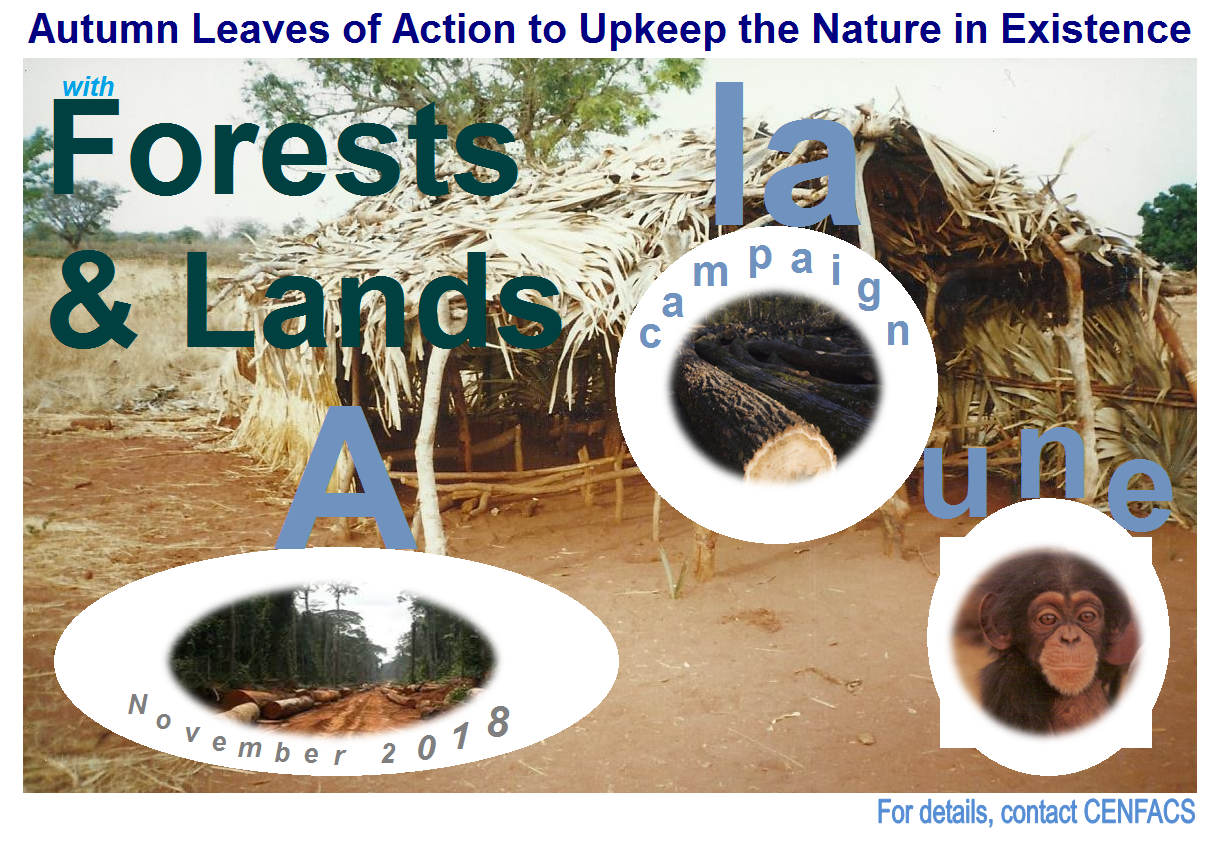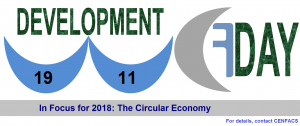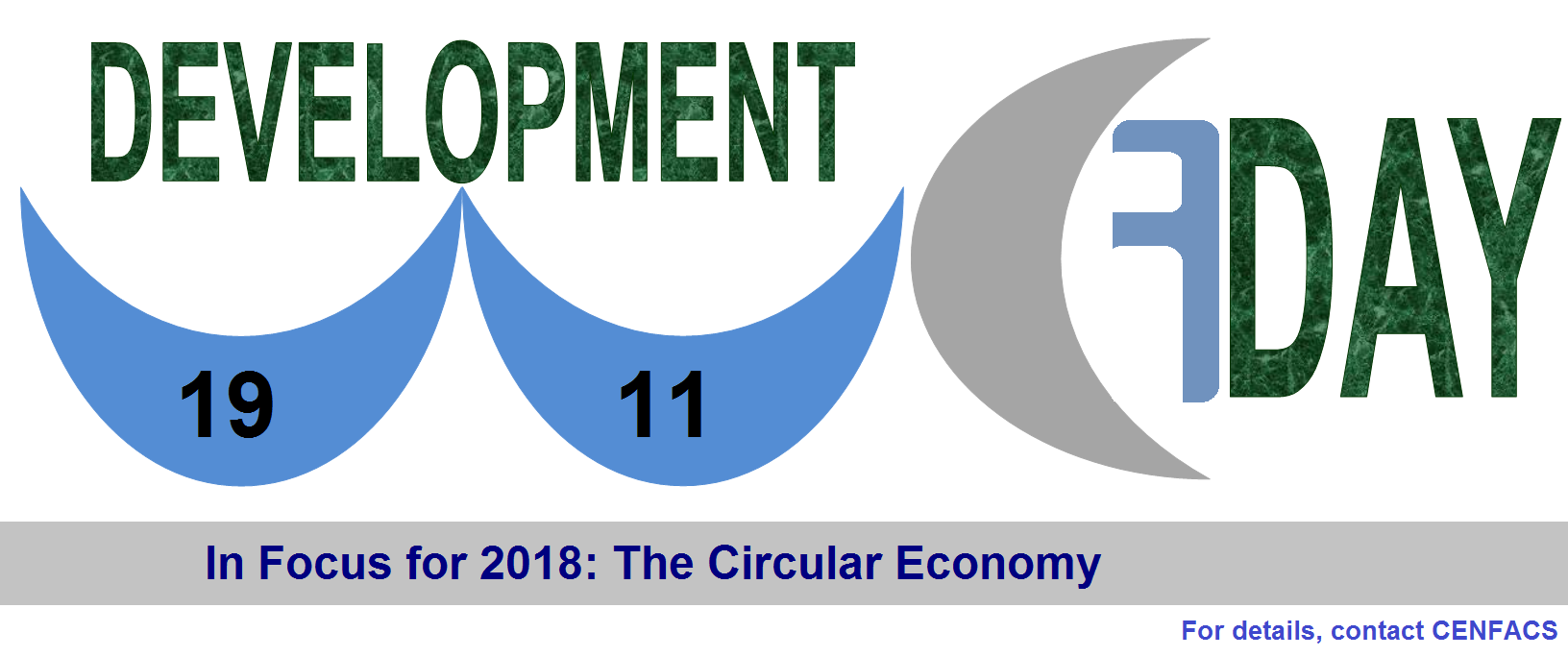Welcome to CENFACS’ Online Diary!
14 November 2018
Post No. 65
The Week’s Contents
• Skills Development Month continues with Disruptive Skills
• A la une campaign with Forests and Lands
• Women and Children FIRST Development Day with the Circular Economy
… and much, much more!
Key Messages from the Week’s Contents
~ Disruptive Skills for Poverty Relief and Sustainable Development
Our Skills Development month or the month of the Economics of Education and Skill Formation continues this week by looking at any further or better skills we need as a CENFACS Community to continue to help to reduce poverty and enhance sustainable development.
We are focusing on Disruptive Skills to do that. Disruptive Poverty Relief Skills are those can significantly alter the way the entire poverty relief industry operates. These are the abilities and talents that may enable someone to add to or move away from traditional established ways of dealing with poverty. In doing so, they will help to access new markets and value networks or chains as well as to develop new products and tools to deal with poverty and unsustainable development.
For more on Disruptive Skills for Poverty Relief and Sustainable Development, contact CENFACS.
~ A la une campaign with a focus on Forests and Lands
Our A la une campaign continues as well with the last themed area of work, which is Forests and Lands. This week we will try again to push forward for the understanding of the forest lands issue, and action to deal with this issue. The outcome from this week’s sub-campaign is to help trigger change of mindset and action for the upkeep of forests (i.e. trees and wood plants) and lands.
The campaign activities include the three following links:
√ Links between forests, lands and species of flora and fauna
√ Links between forests, lands and poverty relief
√ Links between forests, lands and sustainable development
Further details about this themed area of work are given under the Main Developments section of this post.
~ Women and Children FIRST Development Day (WCFDD) with the Circular Economy
High on the next week’s agenda will be our 9th Development Day. This year’s focus is on the Circular Economy, on how it can be used to empower families, in particular but not exclusively women/mothers and children. In our thoughts, we will be using decoupling theories of the circular economy, theories that push forward for the decoupling economic development from consumption and exploitation of natural resources.
For more on WCFDD, read under the Main Developments section of this post.
Extra messages
~ Festive Income Booster: Festive Work
Promoting the right of celebration for Poor Children, Young People and Families by boosting their income over the festive season continues to occupy our November poverty relief and sustainable development agendas. Likewise, Festive Work as Season’s theme from this year’s edition of Festive Income Booster is also preoccupying our mindset. To access this Individual Capacity Development Programme resource, contact CENFACS.
~ Charity e-Store: Festive SHOPPING and DONATIONS!
Every occasion and or every season is an opportunity to do something against poverty and hardships. This coming festive season is one of them and is a great time to share precious moments with your love ones. It is also a time to spread a little extra happiness to those who do not have.
You can give your unwanted and unneeded goods to CENFACS’ Charity e-Store, the shop builds to help relieve poverty. You can buy second hand goods and bargain priced new items and much more.
CENFACS’ Charity e-Store needs your support for Festive SHOPPING and DONATIONS.
You can do something different this Festive Season by SHOPPING or DONATIONS GOODS at CENFACS Charity e-Store.
You can DONATE or SHOP or do both:
√ DONATE unwanted GOODS and PRODUCTS to CENFACS Charity e-Store during the festive period 2018
√ SHOP at CENFACS Charity e-Store to support good and deserving causes of poverty relief during the festive period
Your SHOPPING and or GOODS DONATIONS will help to the Upkeep of the Nature and to reduce poverty.
Main Developments from the Week’s Contents
• A la une campaign with Forests and Lands
To undertake the upkeep of forests and lands in Africa and elsewhere, it makes sense to preserve the lives of species of flora and fauna, to continue to reduce poverty and to enhance sustainable development.
In the context of this campaign, it goes without saying with the following causal links which help to elucidate action for the upkeep of the nature: links between forests, lands and poverty reduction; links between forests, lands and species; links between forests, lands and sustainable development.
Let’s see these causal links first, and then explain what we are campaigning for.
•• Causal links that make this themed area of the A la une campaign
Links between forests, lands and poverty reduction
There are documented studies about the benefits of forests for the poor. Many people live in or around forests and enjoy the benefits of forests. According to the Food and Agriculture Organisation of the United Nations (1),
‘Of an estimated 250 million people in or around tropical forests and savannahs living below the extreme poverty line, 63 percent are in Africa’ (p.11).
The same organisation argues that ‘Reliance on wood fuel is highest in Africa (63 percent) (p.17)
In terms of this campaign, let’s simply say the following.
Poor people rely on forests as they share the same space. Forests provide the following benefits. Forests are a source of subsistence for food, fuel, medicine, shelter for forest dwellers, housing materials etc. They can provide savings and insurance for the poor and forest-based economies.
From the above benefits, it is right to advocate that the way humans can deal with forests and forest lands can impact poverty and its reduction. There tends to be economic linkages between rural poverty and land degradation. There seems to be association between poverty alleviation, natural tropical and lands in Africa especially in rural areas.
Links between forests, lands and species of flora and fauna
There are scientific researches which show that forest destruction, habitat fragmentation by human encroachment in forest areas can increase exposure to zoonotic infections via interaction with wildlife reservoir species and enhance exposure to other diseases.
Likewise, it is a matter of fact that dry land forests, which are critical to the survival of humans and animals are under considerable pressure of degradation, are a problem for some species like vulnerable African elephant species and black rhinos. These species depend on eco-systems for management and shelter.
Again, the above suggests that there could be links between the state of forests, lands and the well-being of species of flora and fauna. Campaigning for the reverse of the degradation of dry land forests is a deserving cause for the upkeep of the species of flora and fauna.
Links between forests, lands and sustainable development
Simply speaking sustainable development covers three basic areas: environmental, economic and societal sustainability. If we pick up environmental sustainability, particularly climate change, it is pointless to say that there is a possible link between deforestation and climate change. Deforestation and forest degradation can cause carbon emissions. Reducing the over-exploitation and demand of timber can help for forest resources in Africa and elsewhere.
•• What we are campaigning for this week
Forests and Lands sub-campaign is an action for sustainable forest and land development. It is a crusade to save or rescue species of plants and animals found in the rainforests, especially but not exclusively in the tropical forests of Africa.
It is a drive that addresses the following issues: the destruction of trees of the rainforests by logging, the clearance of vast areas of forests for various reasons, the cutting down of trees and the burning of the scrub etc.
It is a fight against deforestation-related externalities and illegal conversion of forests for export-driven industrial agriculture.
It is finally a stand for the improvement of climate finance for forest conservation, anti-deforestation dividends, the restoration of degraded lands, the protection of vulnerable forests, and the care about forest and land development targets.
To support Forests and Lands sub-campaign and A la une campaign generally, contact CENFACS.
(1) Food and Agriculture Organisation of the United Nations (2018): The State of the World’s Forests 2018 – Forest Pathways to Sustainable Development, Rome, Licence: CC BY-NC-SA 3.0 IGO
•• Coming Next Week: The 9th Women and Children FIRST Development Day (WCFDD)
The coming WCFDD will about thinking ways of working together to come out of the linear model that consists of make, use and dispose goods and resources; to embrace the circular economy. Circular economy or circular economic development has been around for many centuries, but it has never been the economic model that one can think of in the first place when it comes to produce and consume resources.
Every day we hear about re-use, repair and recycle. But, in the way people generally act and behave, only few of them care about these three expressions (re-use, repair and recycle). It is often the paradigm of linear economic model that prevails in humans’ mindset and the way they behave.
This Development Day (DD) is for us to explore paths of making the circular economy as our everyday’s economy from family to work and passing through different aspects of our living outside the family and work circles.
The DD will seek to find strategies to adapt the principles of the circular economy to our daily family life, and to rethink or rebuild family relationships in integrating the circular economy. The DD will have two areas of thoughts (i.e. adaptation and transition to the circular economy). But before getting further about these two areas of our development day of thoughts, let’s define the circular economy.
There are many circular economy schools of thought and definitions of circular economy. For the purpose of our development day, we are going to borrow the definition of circular economy from Ellen McArthur Foundation (2) which defines it in these following terms.
‘Looking beyond the current take-make-dispose extractive industrial model, a circular economy aims to redefine growth, focusing on positive society-wide benefits. It entails gradually decoupling economic activity from the consumption of finite resources, and designing waste out of the system. Underpinned by a transition to renewable energy sources, the circular model builds economic, natural, and social capital. It is based on three principles: a) Design out waste and pollution b) Keep products and materials in use c) Regenerate natural systems.’
This definition can be extended to family life and framework where those making this family are involved. Because our development day is about women/mothers and children, let’s say where women or mothers and children are concerned; their involvement is in their handling or customizing the above three principles. In other words, in terms of family settings, we/they will be trying to think how they can design out waste and pollution, keep products and materials in use, and help regenerate natural systems in their ways of dealing with natural resources.
From the perspective of our development day and of the decoupling theories of circular economy, two areas of thought will be dealt with which are as follows:
1st Area of Thought: Adaptation of the circular economy principles to family models of working and the lives of women/mothers and children.
In this first area of thought, we will be rethinking the key functions of a family and family setting in which its members (here women/mothers and children) are part of. We will then try find out how to adapt to the circular economy or the regenerative economic development or way around how this economy can be adapted to the family life..
2nd Area of Thought: Women’s and children’s transition to a circular economy
The second area of thought will be about the transition process from a linear economic model of managing natural resources to a circular economic model of operating for women/mothers and children. It will be about developing a strategy to work with resilient families (including women/mothers and children) for transitioning to a circular economy, for making both mental and behavioural shifts in embracing the circular economy.
Both adaptation and transition processes will prepare the mindsets of those who are willing to embrace the circular economy to decouple poverty relief and economic development from consumption and exploitation of natural resources. For example, to reduce poverty and enhance sustainable development, those in need do not always have to resort to cut down trees or destroy natural resources. Another example, humans can re-use household items by extracting the maximum value from them before thinking of replacing them with new ones. It is in this way they can help build economic, natural, and social capital they need.
This DD will be conducted under CENFACS’ Women and Children Sustainable Development projects.
To support the DD and CENFACS, contact CENFACS.
(2)https://www.ellenmacarthurfoundation.org/circular-economy/concept (accessed on 09/11/2018)
WCFDD Timeline: 2010 to 2017
Since its inception in 2010, the WCFDD provides an opportunity and scope to communicate CENFACS’ anti-poverty work/message and the need to develop new ideas and proposals, and improve practices to enable us to enhance the quality of life of multi-dimensionally-deprived women/mothers and children.
In 2010, the WCFDD was devoted to AWARENESS on SUSTAINABLE ACCESS TO & PROTECTION OF ENVIRONMENTAL RESOURCES AND ENERGIES
In 2011, CENFACS’ WCFDD tackled the challenging issue of BARRIERS TO POVERTY REDUCTION, with a special emphasis on one particular way of overcoming them, which is participation. Women & Children’s Participation was looked at within the context of Race in the Road to Poverty Reduction.
In 2012, our Development Day in Putting Women and Children FIRST went further with the sub-theme of participation as it was organised around the theme of IMPROVING WOMEN’S AND CHILDREN’S PARTICIPATION IN THE RACE TO REDUCE POVERTY.
In 2013, WCFDD at CENFACS extended and deepened the idea of more and better participation by focussing on Infrastructures for Women’s and Children’s contribution to poverty relief. The theme for 2013 was “INFRASTRUCTURES FOR A POSITIVE ECONOMY TO REDUCE POVERTY”.
In 2014, we guesstimated and compared the cost for acting to the cost for inaction to reduce poverty. The theme of COSTING DOING NOTHING FOR POVERTY RELIEF improves our understanding on an early prevention that helps reduce costs and avoid escalating or detrimental effects for poor Women and Children.
In 2015, WCFDD was dedicated to MAKING THE 2030 AGENDA FOR SUSTAINABLE DEVELOPMENT WORK FOR WOMEN & CHILDREN (W&C). This was the local community response from the W&C of CENFACS to the 2030 Global Agenda and Goals for Sustainable Development.
In 2016, The theme for our Development Day was ENSURING HEALTHY LIVES AND PROMOTING WELL-BEING FOR WOMEN & CHILDREN. This was the continuation of 2015 development day. Ensure-Healthy-Lives-and-Promote-Well-being is itself Goal no.3 of the United Nations Sustainable Development Goals. One day of development thoughts does not make the 2030 Agenda works as we need more times and days. But it helped to look at Goal 3 (G3) as both global and local concept, G3 as a practical response and G3 as Protection for W&C in the CENFACS’ Year of Protections.
In 2017, ENDING POVERTY IN ALL ITS FORMS EVERYWHERE FOR WOMEN AND CHILDREN was our working theme for the WCFDD
Note: For your information,
3W (What Women Want) is a CENFACS support network scheme to enhance the lives of multi-dimensionally deprived women/mothers and families.
PPS (Peace, Protection & Sustainability) is a CENFACS child and environmental protection programme to support multi-dimensionally vulnerable children, young people and families
W&CSDP (Women & Children Sustainable Development projects) – a CENFACS amalgamation of 3W and PPS projects
Help CENFACS keep the Poverty Relief work going
We do our work on a very small budget and on a voluntary basis. Making a donation will show us you value our work and support CENFACS’ work which is currently offered as a free service.
Donate to support CENFACS!
FOR ONLY £1, YOU CAN SUPPORT CENFACS AND CENFACS’ PROJECTS, JUST GO TO http://cenfacs.org.uk/supporting-us/
Thank you for visiting CENFACS website and reading this post.
Thank you as well to those who made or make comments about our weekly posts.
We look forward to receiving your regular visits and continuing support throughout 2018.
With many thanks




